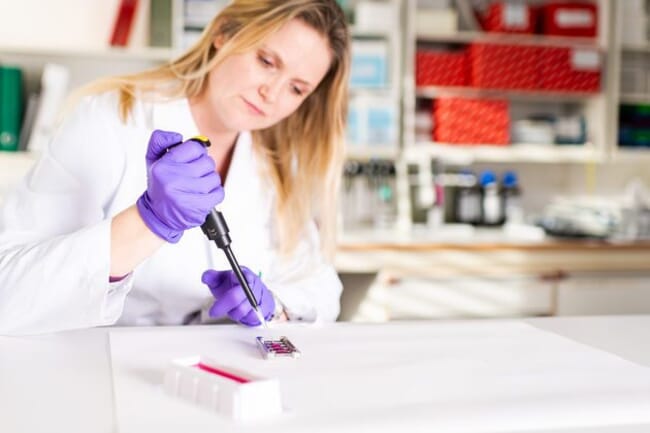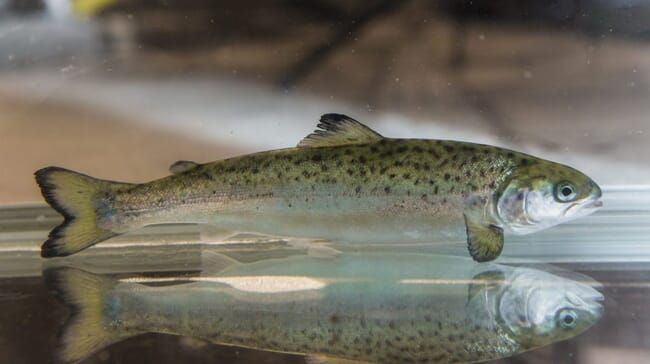
Engineer Marianne HS Hansen in Nofima’s lab have analysed large amounts of genetic material in order to build up a database of gene activity, which forms the basis for the test © Joe Urrutia, Nofima
The test can provide information that fish farmers will benefit from when transferring salmon smolt from freshwater to the sea. The results can help increase the smolts’ chances of survival. Every year, approximately 15 percent of farmed salmon die after being transferred from land-based freshwater tanks to net-pens at sea. Most of these fish die shortly after being transferred – making the test highly relevant for the industry.
How do you test immune status?
Nofima has developed a diagnostic test that measures the activity of 44 genes that regulate the immune system. A sample is taken from the gills or the dorsal fin without harming the fish.
“A few years ago, we found that the immune system was weakened during smoltification. As a result, we decided to develop a test to measure the immune status of salmon during smoltification,” says Aleksei Krasnov, senior scientist at Nofima.

Krasnov and his team used genetic data to develop a database that underpins the diagnostics of the immune status © Nofima
To do that, Krasnov and his colleagues evaluated multiple genes and selected those that provided the most information about immune status. The scientists compiled large amounts of data from different in-house experiments at Nofima. Krasnov isn’t aware of any other research body that has such a substantial and well-organised database for gene expression in salmon. The activity of the selected genes was analysed from various fish farming sites, different groups of fish and different environmental conditions. The scientists used this data to develop a database that provided the basis for the diagnostics of the immune status.
Gene activity reveals the body’s plan
The genes give “orders” to the body’s cells to produce proteins that have a given function. Genes may increase or decrease activity long before we can see changes in fish condition. Scientists measure activity of carefully selected genes for assessment of salmon immune status and health.
The scientists identified the normal activity level for each of the 44 genes in fish that are in good condition. If the activity level is too high or too low, it may indicate poor immune status. This means that they can now offer tests for immune status in salmon smolt.
“We are able to see which fish are in good condition and which are not. In addition, we know which fish seem healthy, but in reality are not,” Krasnov says.
Industry representative, Dr Gordon Ritchie, who is Group Manager Fish Health & Welfare in Mowi ASA, is co-author on the latest article.
“The successful development of this novel technique provides companies with a new tool in the smolt quality assessment box, for verifying the immune competency and robustness of smolt before transfer to sea. This immune status diagnostic tool can also be utilised in future research projects on smolt performance and survival,” Ritchie comments.

Scientists have now developed a test that measures the immune status of salmon smolt © Terje Aamodt, Nofima
Using the new test in other projects
Krasnov also sees the benefits of using the test in other research projects.
“We used the test in the CtrlAQUA research centre to test whether different ways of producing large smolt in closed recirculation facilities affect immune status before transfer to sea takes place. The test showed that immune status was the same for the different production methods. We also use the test in projects where the nutrition scientists investigate whether feed ingredients affect fish health,” says Krasnov.
He is happy to contribute more information to interested parties about how the industry can benefit from this new tool.




